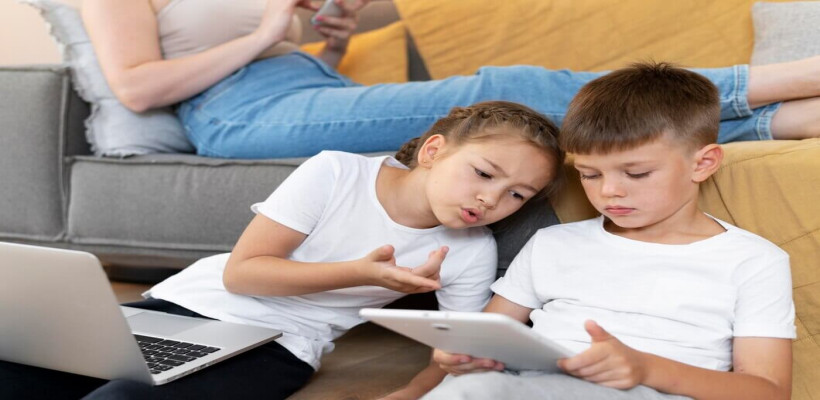The infamous argument about screen time might seem to go on forever. Parents want their children to have less of it, while children want more. It's nearly impossible to resist technology as it permeates every aspect of our life. Not only for enjoyment, we now depend on technology for education and social connection.
Finding the ideal balance or simply understanding what "balanced" means can be challenging. The shame and anxiety are exacerbated by the negative connotations around children and screen time. What is too much? When does it become harmful?
Perhaps it's time for some wonderful news that will soothe your anxiety. According to recent research, technology may not be as harmful to children as first believed and that what matters most is the quality of screen time rather than its amount.
What Do We Know About the Effects of Screen Time on Kids?
Even scientists are divided on this issue, so parents are not alone. Although it may seem like there is agreement on the subject, this is not. The findings drawn from the available research are disputed by several psychologists.
Why? Insufficient research has been conducted, the findings are contradictory, and there is scant evidence linking screen usage to behavioral and mental health issues.
A Lack of Research
Technology is still in its infancy. Too little time has been available to conduct long-term, definitive research. Regretfully, there are other problems besides time. Finding parents who would permit a minimum of six hours of screen usage per day, or perhaps none at all, for an extended length of time is difficult.
There are further issues. A large portion of the research is cross-sectional, correlational, or self-report based. Research has depended on the observations and emotions of both parents and children, which increases the possibility of biased and distorted results.
Conflicting Results and New Information
How often have you heard that a child's sleep might be disturbed by screen time? Or that your youngster may become grumpy or melancholy as a result of excessive screen time? Despite being supported by earlier research and believed to be true, scientists are now reaching different results.
What is the real impact on a child's sleep and mood?
According to a recent study, children's sleep is only slightly disrupted by an average reduction of 3 to 8 minutes per hour of screen use. [4]. Know what your child can handle because some children may be more sensitive than others. Cutting off screen time an hour before bed and using a blue light blocker can both be beneficial. Focusing on a regular wake-up time and nighttime routine is generally more advantageous.
What about how it affects moodiness? It would take more than five hours of screen usage on a device before parents or other caregivers would observe an improvement in psychosocial functioning, per one study.
Does It Cause Depression and Anxiety?
There is also debate on the relationship between screen usage and a child's or teen's mental health. Researchers are questioning the association since studies have not consistently shown a causal relationship.
Which came first, the egg or the chicken? Similarly, could excessive screen usage contribute to mental health problems in adolescents? Or does the child's increased screen time stem from mental health problems? Causation is not implied by correlation. Children who struggle with anxiety and despair may just be more prone to excessive phone use.
Why Quality Over Quantity Is the New Focus
Researchers are discovering that screen time is not all the same, despite the fact that it is frequently grouped into one category. The topic is more complex than a straightforward "good" or "bad."
Consider it food. Not every food has the same effect on the body. There are things that are very helpful, things that are only slightly helpful, and those that are bad or even dangerous.
Additionally, time must be considered. Eating a few of cookies on a single day is not the same as eating them many times a day, every day, for years. The long-term changes that can occur are even more serious than the short-term ones.
What type of screen time is therefore "healthier"? There are two types of it: active and passive.
Active Screen Time
The child's brain will be stimulated and forced to think through interactive programs and games. Anything that promotes critical thinking, creativity, and problem-solving abilities can be used, including video games, movies, conversation, and apps for active learning.
Passive Screen Time
The child "veges out" during this idle period by watching TV series or movies and browsing social media. It is still possible to occasionally enjoy these activities, but moderation is required. Children may suffer as a result of this passive screen time.
It’s Not Always Black and white
That makes it simple, doesn't it? False. Determining whether screen time is active or passive makes decision-making simpler, but it doesn't stop there. A video or game may appear instructive at first, but it may not be really useful.
Similarly, something that appears to be idle time can actually be quite instructive. It is impossible to navigate this complicated subject without taking quality into account, but doing so requires perseverance and patience.
The Surprising Benefits of Screen Time for Kids
Despite the negative attention that technology attracts, children are surrounded by it and will inevitably interact with it. Finding balance can be facilitated by focusing on the positives. What are the advantages of active screen time for children?
Video games
Although they can be classified as active, video games have a negative reputation and are frequently seen as a waste of time. While the advantages of each video game differ, the majority are linked to the following:
– Processing images
– Pay attention
– Coordination of the hands and eyes
– Processing in space
– Solving problems
– Originality
– Self-control
– Discovery of social interaction
Educational Programs
Despite being promoted as instructional, some shows may not live up to the hype. Nonetheless, the majority aim to offer children high-quality information and support for the following:
– Being literate
– Recognition of color, numbers, and letters
– Imagination
– Character growth
– exposure to other locations and cultures
A child's use of technology can also help them develop tech-savvy, which is a crucial future ability. Children are more adept at adjusting to new situations. They have the opportunity to acquire self-regulation while becoming acquainted with technology as they grew up with it.
When Active Screen Time Isn’t Good Enough
Interactive games and films are not enough for children under two. They lack the maturity to learn from digital media because of their symbolic, memory, and attentional deficiencies. They can't translate what they see on the screen to the real world. At this age, a child's hands-on play and interpersonal interactions help them develop their cognitive, verbal, motor, social, and emotional skills.
This is not to say that young children should never use screens, but it should be sparse and a time for socialization.
The Negative Impact of Screen Time
Naturally, a balance is required. Even if screen time may not be harmful, there are still a lot of possible issues to be mindful of. The drawbacks are frequently presented as though they are independent, although they are typically signs of more serious problems.
Which is the most significant issue? Real-life activities are diminished by screen time.
When screen time takes the place of healthy routines and activities, problems including obesity, moodiness, lack of focus, and sleep deprivation arise. What we allow technology to replace is what poses a threat, not the technology itself. As a result, children are less active, stay up later, and become distracted. This also applies to adults.
Parents shouldn't disregard the most recent recommendations on screen time, though. The long-term implications are too soon to tell, although moderation is wise. Encouragement of play, activity, and even boredom is important for children. Creativity begins with boredom.
Children and teenagers who pay attention to their feelings can develop self-regulation skills. By evaluating their time, concentrating on their objectives, and seeking out authentic experiences, everyone may learn to "unplug."
What to Do When You Think There Is an Addiction
When you try to take away your child's phone or tablet, does he or she get upset? Does your youngster appear to prefer it and want to use it frequently? Do not be concerned. Addiction is not implied by that. It might just be frustration.
Like adults, children may find it difficult to switch tasks abruptly. Allow your child to get used to interruptions because they can be distressing. Allow five or ten minutes to "warn" that the allotted time is almost up. To make the shift easier, engage with them and get them to step outside of their comfort zone.
What happens if that fails? What if excessive screen time begins to lead to more serious issues?
8 Signs of Screen Dependency Disorder
As they watch their children stare blankly at a screen and get upset when it's time to turn it off, parents naturally worry about addiction. According to Neurohealth Associates, here are some signs that your child may have control issues:
– Addiction to Withdrawal
– A greater capacity for tolerance
– Not cutting back on or ceasing to use screens
– Loss of other passions
– persists in spite of adverse effects
– Making false claims about use
– Uses to get out of bad moods
Screen Dependency Disorder and Your Child’s Health
This condition may have both immediate and long-term detrimental effects on your child's health. What kinds of issues may it lead to?
Short-Term Health Problems
- – insomnia
- – back pain
- – weight gain or loss
- – vision problems
- – headaches
- – anxiety
- – dishonesty
- – feelings of guilt and loneliness
- – aggression
Long-Term Health Problems
Addiction causes the striatum, insula, and frontal lobe of a child's brain to gradually deteriorate. What particular effects does that have on growth and behavior? A youngster who experiences this tissue loss may struggle with:
– Organizing and planning
– suppressing desires that are socially inappropriate
– Gaining empathy and compassion
– Speech
7 Steps to Help Break the Screen Time Cycle
Although actual addiction is uncommon, your child will most likely require a detox at some point. You may determine that everyone needs a break or that screen time should be reduced overall. What are some ways to ease this transition? Nobody wants needless drama, after all.
- Create a plan. Talk with your child(ren), discuss concerns, and get everyone’s feedback.
- Pick a start date. Set a future date, giving children time to accept the plan.
- Make a list of alternative things to do. Be prepared for the inevitable “I’m bored.” Bins of toys, games, crafts, and books can encourage play.
- Keep devices out of sight. There will be less temptation if they’re out of view.
- Play with your child. Some kids need a boost, and your involvement will make them want to play even more.
- Be a good role model. Kids will mimic your behavior, so limit your own screentime.
- Create new routines. Kids often use screentime out of habit. Find the times your child is most likely to use it, and help fill in that space with something else.
How to Find a Balance That’s Right for Your Family
Since every family is unique, what works for one won't always work for another. You don't need to base your rules on what other people do. Nobody knows your children as well as you do.
Here are some pointers for striking the ideal balance. Keep in mind that as your children get older, you will most likely need to make changes.
Participate. When parents or other caregivers actively interact with their children during screen time, they learn more. It's a fantastic method to establish a bond with your child. You'll also have more insight and control because you'll know what they're watching and playing.
Establish tech-free areas and periods. This could occur after school, before bed, or during meals. Determine the precise times and locations where using a screen is prohibited. Select the option that best suits the schedule of your family.
Do not multitask. When the brain is forced to perform several tasks at once, the outcome is subpar output. Encourage children to concentrate on a single task at a time.
Instruct self-control and consciousness. Make sure your youngster understands the distinction between passive and active screen time. As they play games or watch shows, assist children in becoming conscious of their emotions.
Give them some authority. This will teach children responsibility and lessen the sense that screen time is "special," even though it may seem counterintuitive. Children will want it much more if it is used as a treat or reward. Once screen time is normalized, children will eventually grow disinterested in it.
Consult a professional. You can create a plan for your family with the aid of numerous useful tools. Understand the most recent guidelines and suggestions made by psychologists and pediatricians.
Recall that you are the only one who truly knows your child. If you lead by example, remain active, and find other family activities, balance and control will come easily.








Commnets 0